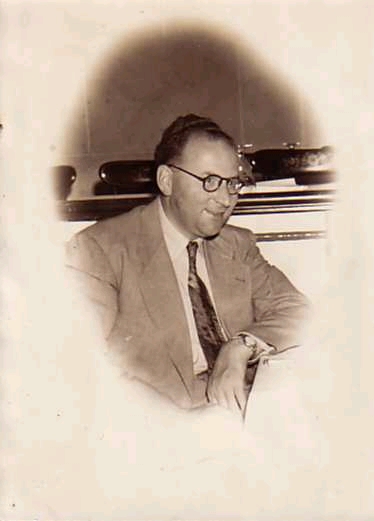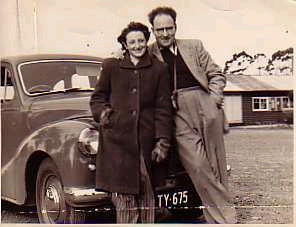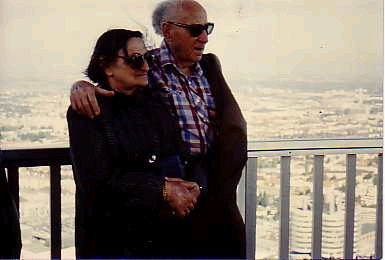 |
Franz
MENZEL was born in Vienna on 29th December 1912. He was not the
only son of his parents Theodor MENZEL and Irma nee RECHNITZER, but his
brother (possibly called Karl--date of birth unidentified) died in
Vienna around the age of 10 from polio. Finishing his degree in
electrical engineering in Vienna in 1933, Franz was eager to do better
than was possible in an increasingly anti-Semitic city, and travelled
to London. Here he seems to have worked as a trainee draughtsman,
probably designing electrical circuits, and progressing to Product
Engineer, a job with which he was very pleased. His mother
reported that he was well-paid enough to not require parental
support. His parents left Vienna for Luxembourg, probably in late
1938 or early 1939, and visited Franz (not for the first time) in late
August 1939 in England but returned to Luxembourg just before the
outbreak of the war, where they were then trapped (and eventually taken
to Lódz ghetto where his father died and whence his mother was
almost certainly taken to the Chelmno death camp). Franz was in
contact with his cousin, <living>, also in England in 1940 (he
scolded her for not keeping in touch with her parents) from a small and
cold room at St. Margaret's, Bath Rd, Slough, near London. There
he was pleased to have a built-in cupboard large enough to stash his
trunk, and content not to have a girlfriend, commenting "who knows what
they are for".
On June 28, 1940, Franz was arrested at 241 Cromwell Rd, London, SW5, and taken into internment to the camp at Kempton Park, used for internees for transit purposes. Franz gave as his employer Telson Electric Co., Manchester 9, and his private address as 241 Cromwell Rd. For his "next of kin", he listed the company name Hammer & Theelen, of 39/40 Gutter Lane, London, EC2. By 1941, Hammer & Theelen had moved to St. Paul's Churchyard EC4, but Franz had been moved to Sydney, Australia, on the infamous HMT Dunera.
The ship and its 2550 passengers zig-zagged for nearly 2 months, survived a torpedo attack and set down at Melbourne the 345 Germans considered Category 'A' (hostile so Nazi-supporting) captives and 200 Italians aboard. Franz was among the 1997 others disembarded on 6 September 1940 at Darling Harbour, Sydney. "From Sydney, the internees were taken by train to near Hay, N.S.W. where they were locked up behind barbed wire in a camp, twenty-eight people in each hut. It was the beginning of Spring, the month of September, when they arrived in Hay. They had nothing else with them except the little clothing they wore, because, whatever was not thrown overboard when the Nazi submarine attacked, the guards had helped themselves." [Ben Zion Patkin's papers at the Archive of Australian Judaica] Franz's personal effects on arrival are shown on his report on Internees as "nil".
The report drawn up about him at that time lists Franz as 5 foot 9 inches high, a 200 lb. weight all the more astonishing after the 58 day Dunera voyage, of fair hair and complexion, with brown eyes and no distinguishing marks, single and of Jewish religion. The reason for internment is given as "Enemy Alien" (Refugee from Nazi oppression)".
Before he was released on 12th October 1941, Franz's "Internee Service And Casualty Form" records that he was moved between 4 internment camps (Hay, Tatura, Loveday and Liverpool) in Australia, in marches of 5, 19 and 43 days. This included 37 weeks at Hay Camp and 82 days at Tatura Camp (near Melbourne, where the Category 'A'--presumably Nazi--internees were held). About Hay, Franz himself said "I had the impression that Hay consisted of the railway station and the camp, and nothing else. We only saw a few sheep occasionally. I really didn't see any real living person, apart from the guards and the postman who came once a week. No other people." When the UK government realised that internees were not necessarily enemies, and released those in category B, many of the so-called "Dunera boys" chose to stay in Australia but Franz decided to return to England and arrived in Liverpool on 18th November 1941, via Singapore on the Stirling Castle, after a more direct return voyage of 37 days dodging submarines. I have been unable to find out why he wanted to return to England--was it to try to help his parents? Did he even know that they had been deported from Luxembourg ot Lódz ghetto exactly 1 month before his return to England? Had he already met his future wife, Rachella HOFFMANN?
Franz's own words survive in an interview he gave in 1991 at a 50 year reunion of the Dunera Boys and transcribed in Haywire (compiled for the Hay Historical Society). "I wrote to the company that I worked for before I was interned, and asked them to apply for my release, and they thought that I had not only been interned, I had been deported to Australia, and therefore there must be something wrong with me, and when I came back to England, and I got into the Pioneer corps, and I got the full uniform, steel hat, gas mask, and what have you, I went to see them, and they fell onto their collective behinds. They realised I wasn't such a dangerous person, and they applied for my transfer from active service to the Army Reserve. Which eventually came through, and I then worked in England in that company, I worked on the H2S, which for you is a code word, but it was originally a bomb radar equipment. Then I worked on depth charge release mechanisms, and I worked on de-gaussing. De-gaussing, you may have heard, is equipment which prevented ships exploding magnetic mines. Those were all very interesting jobs. And I stayed with that firm till '47. In '47 by that time I had married, and we decided to come to Australia, and I came to Melbourne."
Franz and Rachella HOFFMANN married in London in 1942. They appear to have rented rooms at 16 Lansdowne Avenue, Slough, before getting their passport in January 1947, visas in June and booking their emigration. For this journey to Australia, Franz is recorded on the Hawaii Passenger Lists as having traveled in some style with his wife (called Rachel on the list) on Pan American Airways Flight Number NC88957 from San Francisco on August 24, 1946 and arriving at Mascot Airport, Sydney three days later.
Franz gave a personal statement on arrival
which listed as relative George KRAUS of 285 St. Kilda St., Melbourne,
and proposed that as their permanent address in Australia.
George, who had come alone to Melbourne in 1939 from Vienna, married
Rachella's sister Misa HOFFMANN before 1941. He was a wealthy man
and they had used their home as something of a social focus for the
Dunera Boys and may have met Franz in 1940/41. In the words of a
former neighbour, George and Misa "provided a home for all those who
had
no other way of meeting anyone".
Franz worked at a firm called Riley Dodds for many years, designing the electrical system for boilers. In his own words again, "In Melbourne I got into a construction company, the electric instrumentation engineer and there designed control systems for a number of major power stations, the first one having been Munmorah. I don't know whether you know where that is. That's near Newcastle, up on the coast a bit further north than Sydney. Then the controls for the early Darwin power station--Stokes Hill, for Gladstone, for Port Augusta, for Muja, Western Australia, for Bunbury W.A., you name it. And my last job was the cabling design for Loy Yang in Victoria. And then I gave it up, because by that time I was too old, and I had to retire twice beofre I had to retire finally." In fact, Franz worked until he was 72.
Rachella became known as "Relly" and she and Franz remained together, childless, all their lives until Franz died in 1997. According to a relative, "Franz and Relly lived quite frugally in a modest house in Bentleigh [Melbourne] until they died. They went on many trips to various parts of Australia, to New Zealand and several times to Europe."
Franz appeared delighted with the decision to move to Australia. In the 1991 interview he said, "Australia was very good to me. From social parts of Europe and the financial parts of Europe and from the point of view of ecology, it's much better. It's a much more open country. And then I went back to England in '65, and I had to go from London to Norwich. The first two hundred miles we didn't get outside the thirty miles per hour speed limit, that's something which is unheard of in Australia. After two hundred miles you are in the bush, wherever you start. So Australia is very good to me and we are really pleased we made the decision to come to Australia."
When George KRAUS died at age 56 in 1962, his memorial began a small community of friends in Springvale Cemetery, Melbourne. His ashes were joined by the ashes of his wife Misa, who died in England in 1964, then in 1986 by those of Misa and Rachella's brother Abraham Jacob (Jack), then by those of Franz on May 15, 1997, and finally by those of Rachella (Relly) on Feb. 7, 2000. They are all remembered in Cassia, Individual Tree Garden 6 by Tree 20.....and by this short account.
On June 28, 1940, Franz was arrested at 241 Cromwell Rd, London, SW5, and taken into internment to the camp at Kempton Park, used for internees for transit purposes. Franz gave as his employer Telson Electric Co., Manchester 9, and his private address as 241 Cromwell Rd. For his "next of kin", he listed the company name Hammer & Theelen, of 39/40 Gutter Lane, London, EC2. By 1941, Hammer & Theelen had moved to St. Paul's Churchyard EC4, but Franz had been moved to Sydney, Australia, on the infamous HMT Dunera.
The ship and its 2550 passengers zig-zagged for nearly 2 months, survived a torpedo attack and set down at Melbourne the 345 Germans considered Category 'A' (hostile so Nazi-supporting) captives and 200 Italians aboard. Franz was among the 1997 others disembarded on 6 September 1940 at Darling Harbour, Sydney. "From Sydney, the internees were taken by train to near Hay, N.S.W. where they were locked up behind barbed wire in a camp, twenty-eight people in each hut. It was the beginning of Spring, the month of September, when they arrived in Hay. They had nothing else with them except the little clothing they wore, because, whatever was not thrown overboard when the Nazi submarine attacked, the guards had helped themselves." [Ben Zion Patkin's papers at the Archive of Australian Judaica] Franz's personal effects on arrival are shown on his report on Internees as "nil".
The report drawn up about him at that time lists Franz as 5 foot 9 inches high, a 200 lb. weight all the more astonishing after the 58 day Dunera voyage, of fair hair and complexion, with brown eyes and no distinguishing marks, single and of Jewish religion. The reason for internment is given as "Enemy Alien" (Refugee from Nazi oppression)".
Before he was released on 12th October 1941, Franz's "Internee Service And Casualty Form" records that he was moved between 4 internment camps (Hay, Tatura, Loveday and Liverpool) in Australia, in marches of 5, 19 and 43 days. This included 37 weeks at Hay Camp and 82 days at Tatura Camp (near Melbourne, where the Category 'A'--presumably Nazi--internees were held). About Hay, Franz himself said "I had the impression that Hay consisted of the railway station and the camp, and nothing else. We only saw a few sheep occasionally. I really didn't see any real living person, apart from the guards and the postman who came once a week. No other people." When the UK government realised that internees were not necessarily enemies, and released those in category B, many of the so-called "Dunera boys" chose to stay in Australia but Franz decided to return to England and arrived in Liverpool on 18th November 1941, via Singapore on the Stirling Castle, after a more direct return voyage of 37 days dodging submarines. I have been unable to find out why he wanted to return to England--was it to try to help his parents? Did he even know that they had been deported from Luxembourg ot Lódz ghetto exactly 1 month before his return to England? Had he already met his future wife, Rachella HOFFMANN?
Franz's own words survive in an interview he gave in 1991 at a 50 year reunion of the Dunera Boys and transcribed in Haywire (compiled for the Hay Historical Society). "I wrote to the company that I worked for before I was interned, and asked them to apply for my release, and they thought that I had not only been interned, I had been deported to Australia, and therefore there must be something wrong with me, and when I came back to England, and I got into the Pioneer corps, and I got the full uniform, steel hat, gas mask, and what have you, I went to see them, and they fell onto their collective behinds. They realised I wasn't such a dangerous person, and they applied for my transfer from active service to the Army Reserve. Which eventually came through, and I then worked in England in that company, I worked on the H2S, which for you is a code word, but it was originally a bomb radar equipment. Then I worked on depth charge release mechanisms, and I worked on de-gaussing. De-gaussing, you may have heard, is equipment which prevented ships exploding magnetic mines. Those were all very interesting jobs. And I stayed with that firm till '47. In '47 by that time I had married, and we decided to come to Australia, and I came to Melbourne."
Franz and Rachella HOFFMANN married in London in 1942. They appear to have rented rooms at 16 Lansdowne Avenue, Slough, before getting their passport in January 1947, visas in June and booking their emigration. For this journey to Australia, Franz is recorded on the Hawaii Passenger Lists as having traveled in some style with his wife (called Rachel on the list) on Pan American Airways Flight Number NC88957 from San Francisco on August 24, 1946 and arriving at Mascot Airport, Sydney three days later.
 |
Franz worked at a firm called Riley Dodds for many years, designing the electrical system for boilers. In his own words again, "In Melbourne I got into a construction company, the electric instrumentation engineer and there designed control systems for a number of major power stations, the first one having been Munmorah. I don't know whether you know where that is. That's near Newcastle, up on the coast a bit further north than Sydney. Then the controls for the early Darwin power station--Stokes Hill, for Gladstone, for Port Augusta, for Muja, Western Australia, for Bunbury W.A., you name it. And my last job was the cabling design for Loy Yang in Victoria. And then I gave it up, because by that time I was too old, and I had to retire twice beofre I had to retire finally." In fact, Franz worked until he was 72.
Rachella became known as "Relly" and she and Franz remained together, childless, all their lives until Franz died in 1997. According to a relative, "Franz and Relly lived quite frugally in a modest house in Bentleigh [Melbourne] until they died. They went on many trips to various parts of Australia, to New Zealand and several times to Europe."
Franz appeared delighted with the decision to move to Australia. In the 1991 interview he said, "Australia was very good to me. From social parts of Europe and the financial parts of Europe and from the point of view of ecology, it's much better. It's a much more open country. And then I went back to England in '65, and I had to go from London to Norwich. The first two hundred miles we didn't get outside the thirty miles per hour speed limit, that's something which is unheard of in Australia. After two hundred miles you are in the bush, wherever you start. So Australia is very good to me and we are really pleased we made the decision to come to Australia."
When George KRAUS died at age 56 in 1962, his memorial began a small community of friends in Springvale Cemetery, Melbourne. His ashes were joined by the ashes of his wife Misa, who died in England in 1964, then in 1986 by those of Misa and Rachella's brother Abraham Jacob (Jack), then by those of Franz on May 15, 1997, and finally by those of Rachella (Relly) on Feb. 7, 2000. They are all remembered in Cassia, Individual Tree Garden 6 by Tree 20.....and by this short account.
 |
||
| Relly and
Franz MENZEL, 1992 |
| Return to
Körmend home page |
RECHNITZER/Graz2 |
© copyright 2009 Judy Petersen

